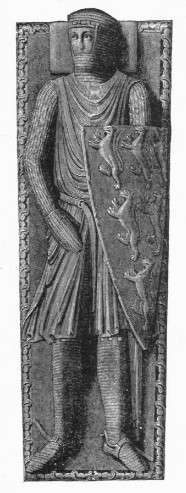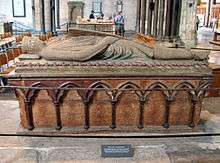William Longespée, 3rd Earl of Salisbury
| William Longespée | |
|---|---|
| Earl of Salisbury | |
 Drawing of effigy of William Longespée from his monument in Salisbury Cathedral | |
| Spouse(s) | Ela, Countess of Salisbury |
|
Issue | |
| Noble family | Plantagenet |
| Father | Henry II, King of England |
| Mother | Ida de Tosny |
| Born | c. 1176 |
| Died |
7 March 1226 (aged 49–50) Salisbury Castle, Salisbury, Wiltshire, England |

William Longespée, 3rd Earl of Salisbury (c. 1176 – 7 March 1226) ("Long Sword", Latinised to de Longa Spatha) was an English noble, primarily remembered for his command of the English forces at the Battle of Damme and for remaining loyal to his half-brother, King John. His nickname "Longespée" is generally taken as a reference to his great size and the outsize weapons he wielded.
Early life
He was an illegitimate son of Henry II, King of England. His mother was unknown for many years until the discovery of a charter William made that mentions "Comitissa Ida, mater mea" (Countess Ida, my mother).[1][2] This referred to Ida de Tosny, a member of the prominent Tosny (or Toesny) family, who had married Roger Bigod, 2nd Earl of Norfolk[3] in 1181.
Prior to the discovery of the charter mentioning Countes Ida, speculation and folklore gave Rosamond Clifford, another misress of Henry II, as William's mother. URL https://www.genealogieonline.nl/en/family-tree-fountaine-fontaine-fountain-lafontaine/P2800.php
King Henry acknowledged William as his son and gave him the honour of Appleby, Lincolnshire, in 1188. Eight years later, his half brother King Richard I married him to a great heiress, Ela of Salisbury, 3rd Countess of Salisbury.
During the reign of King John, Salisbury was at court on several important ceremonial occasions and held various offices: sheriff of Wiltshire; lieutenant of Gascony; constable of Dover; and Lord Warden of the Cinque Ports; and later warden of the Welsh Marches. He was appointed sheriff of Cambridgeshire and Huntingdonshire about 1213.
Military career
He was a commander in the king's Welsh and Irish expeditions of 1210–1212 and was appointed Viceroy of Ireland, jointly with John de Gray, Bishop of Norwich, when the king left for England in 1210.[4] The king also granted him the honour of Eye in Suffolk.
In 1213, Salisbury led a large fleet to Flanders, where he seized or destroyed a good part of a French invasion fleet anchored at or near Damme. This ended the invasion threat but not the conflicts between England and France. In 1214, Salisbury was sent to help Otto IV of Germany, an English ally, who was invading France. Salisbury commanded the right wing of the army at their disastrous defeat in that year at the Battle of Bouvines, where he was captured.
By the time he returned to England, revolt was brewing amongst the barons. Salisbury was one of the few who remained loyal to John. In the civil war that took place the year after the signing of the Magna Carta, Salisbury was one of the leaders of the king's army in the south. He was made High Sheriff of Wiltshire again, this time for life. After raising the siege of Lincoln with William Marshall he was also appointed High Sheriff of Lincolnshire (in addition to his current post as High Sheriff of Somerset) and governor of Lincoln castle. However, after the French prince Louis (later Louis VIII) landed as an ally of the rebels, Salisbury went over to his side. Presumably, he thought John's cause was lost.

After John's death and the departure of Louis, Salisbury, along with many other barons, joined the cause of John's young son, now Henry III of England. He held an influential place in the government during the king's minority and fought in Gascony to help secure the remaining part of the English continental possessions. He was appointed High Sheriff of Devon in 1217 and High Sheriff of Staffordshire and Shropshire in 1224. Salisbury's ship was nearly lost in a storm while returning to England in 1225, and he spent some months in refuge at a monastery on the French island of Ré.
Death
He died not long after his return to England at Salisbury Castle. Roger of Wendover alleged that he was poisoned by Hubert de Burgh. He was buried at Salisbury Cathedral in Salisbury, Wiltshire, England.
William Longespée's tomb was opened in 1791. Bizarrely, the well-preserved corpse of a rat which carried traces of arsenic, was found inside his skull.[5] The rat is now on display in a case at the Salisbury and South Wiltshire Museum.[5]
Likeness
A terracotta statue of Longespée, dating from 1756, is located in the Great Hall of Lacock Abbey in Lacock, Wiltshire, England. A likeness of his wife Ela is also on display, while several other statues are believed to show their children.
Family
By his wife Ela, Countess of Salisbury, he had four sons and six daughters:[6]
- William II Longespée (1212?–1250), who was sometimes called Earl of Salisbury but never legally bore the title because he died before his mother, Countess Ela, who held the earldom until her death in 1261.
- Richard, a canon of Salisbury.
- Stephen (d. 1260), who was seneschal of Gascony and married Emeline de Ridelsford, widow of Hugh de Lacy, 1st Earl of Ulster. Their two daughters were Eleanor Longspee, who married Sir Roger La Zouche and Emeline Longspee, who married Sir Maurice FitzMaurice, Justiciar of Ireland.
- Nicholas (d. 1297), bishop of Salisbury.
- Isabella Longespée, who married Sir William de Vesci.
- Ela Longespée, who first married Thomas de Beaumont, 6th Earl of Warwick, and then married Philip Basset. No issue.[7]
- Ida Longespée, married firstly Ralph who was son of Ralph de Somery, Baron of Dudley, and Margaret, daughter of John Marshal;[7] she married secondly William de Beauchamp, Baron of Bedford, by whom she had six children, including Maud de Beauchamp, wife of Roger de Mowbray.[8]
- Ida II de Longespée (she is alternatively listed as William and Ela's granddaughter: see notes below), married Sir Walter FitzRobert, son of Robert Fitzwalter, by whom she had issue including Ela FitzWalter, wife of William de Odyngsells. Ela's and Williams's grandsons include William de Clinton and John de Grey.[7]
- Mary Longespée, married. No issue.[7]
- Pernel Longespée.
| Peerage of England | ||
|---|---|---|
| Preceded by William |
Earl of Salisbury 1196–1226 With: Ela |
Succeeded by Ela |
References
| Wikimedia Commons has media related to William Longespée, 3rd Earl of Salisbury. |
- ↑ London, Vera CM, 1979. Cartulary of Bradenstoke Priory. Wiltshire Record Society Publications, Devizes, Wiltshire, UK.
- ↑ Reed, Paul C, 2002. "Countess Ida, Mother of William Longespée, Illegitimate Son of Henry II," The American Genealogist, volume 77, page 137.
- ↑ Phair, Raymond W, 2002. "William Longespée, Ralph Bigod, and Countess Ida." The American Genealogist, volume 77, pages 279–281.
- ↑ O'Mahony, Charles (1912). The Viceroys of Ireland. p. 20.
- 1 2 "Medieval Rodent". Salisbury Museum. Retrieved 30 July 2014.
- ↑ Douglas Richardson. Plantagenet Ancestry, Genealogical Company, 2005. pg 456. Google eBook
- 1 2 3 4 Richardson, D. (2011) Plantagenet Ancestry: A Study ... (via Google) pg 577 (Mowbray) pg 94 (Fitzwalter) pg 429
- ↑ This Ida is sometimes confused with Ida II Longespée, who married Sir Walter FitzRobert of Woodham Walter, Essex, by whom she had issue including Ela FitzWalter, wife of William de Odyngsells. Ida II Longespée has been given different parents by different genealogists; G. Andrews Moriarty suggested the two Idas were sisters; Gerald Paget suggests Ida II who married Walter FitzRobert may have been the daughter of William Longespée II, Earl of Salisbury, by his wife, Idoine de Camville.
- Cawley, Charles, Medieval Lands Project on William Longespée, Earl of Salisbury, Medieval Lands database, Foundation for Medieval Genealogy,
.svg.png)